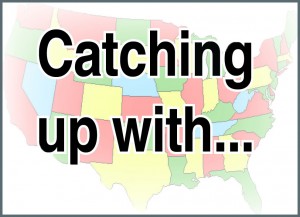Advance CTE’s newly released State Work-Based Learning Toolkit Innovation Tracker links publicly accessible WBL toolkits from across all 50 states and U.S. territories. Well-crafted WBL toolkits allow school districts and industry partners to work together to create a pipeline of career pathways and empower state leaders to ensure that learners have equitable access to programs offering real-world work experience.
The tracker highlights each toolkit’s content across the following categories:

The State Work-Based Learning Toolkit Tracker Analysis provides additional insight into the tracker by highlighting six-state innovations for addressing key program quality components such as equity, data collection, and employer accountability. Below is an example of the kind of analyses featured in the report:
Maryland
- Definition: Work-based learning is defined as “…an instructional strategy that enhances classroom learning by connecting it to the workplace” (U.S. Department of Education, 2017). Work-based learning experiences and programs are traditionally exemplified by job shadowing, internships, and student-based enterprises, and can include an even broader range of related experiences. Work-based learning experiences allow students to “…explore a variety of career options [and] connect the classrooms to the skills needed to be successful in the workplace… [The experiences] are supported by consistent mentoring.”
- Innovative Practice: In addition to emphasizing examples of best practices in designing a work-based learning program through attention-grabbing graphics, such as interest surveys, Maryland has an extensive list of work-based learning-related resources available. This allows CTE administrators, teachers, and employers to build a working knowledge of the science behind work-based learning, internalize the benefits, and better understand how to optimize the experiences for learners. An intentionally designed program means learners will be able to gain the skills they need to successfully navigate their program and enter the workforce fully prepared to contribute.
Through the analysis of 41 publicly available toolkits, several data points emerged regarding the breadth of components found across states:
- State toolkits were organized across multiple approaches, including dedicated websites, comprehensive manual documents, and an online training course in Nebraska.
- Twenty-two state toolkits provided a sample State Learning Plan to guide employers and educators to fully count knowledge and skills gained through the work-based learning experience. Minnesota provided course sequence recommendations to align career seminar courses with work-based learning.
- Twenty-three state toolkits provided employer resources, including sample forms, training documents, liability guidance, and sample evaluations. Alaska, Georgia and Ohio provided extensive resources on labor laws and liability guidance.
One area for improvement that emerged through the analysis was regarding specific support to achieve equitable access to work-based learning for each learner. Very few had toolkits, or linked resources, in multiple languages. Additionally, not all toolkits addressed learners with disabilities. Tracking these toolkits allows Advance CTE to identify additional areas to support, creating equitable frameworks of work-based learning programs for their districts. Last year, Advance CTE released a framework to guide states in building infrastructure that advances access to and completion of equitable work-based learning.
Updates to the tracker will be made quarterly. The analysis and tracker are available for viewing in the Resource Center.
Brice Thomas, Policy Associate


 3.Identify and remove barriers to access, including restrictive costs or entrance requirements, and target specific learner populations for recruitment.
3.Identify and remove barriers to access, including restrictive costs or entrance requirements, and target specific learner populations for recruitment.  5.Expand statewide and inter-state articulation agreements to account for all types of CTE EPSOs. Statewide agreements can help guarantee recognition of CTE EPSO credit and facilitate automatic transfer between a secondary institution and a corresponding postsecondary institution of the learner’s choice. Ensuring that the transfer of credit is as frictionless as possible is vital to supporting learners as they transition into postsecondary education and continue in a degree program. As states work to ensure that each learner’s EPSO experiences consistently are counted toward articulated credit, they should also ensure that this credit contributes to core credits in a CTE program of study and not just elective credit. States can develop additional guidelines and legislation that ensures the connection between an EPSO and a program of study. Ohio has Career-Technical Assurance Guides (CTAGs) that provide automatically articulated and transferable credit upon completion of CTE coursework.
5.Expand statewide and inter-state articulation agreements to account for all types of CTE EPSOs. Statewide agreements can help guarantee recognition of CTE EPSO credit and facilitate automatic transfer between a secondary institution and a corresponding postsecondary institution of the learner’s choice. Ensuring that the transfer of credit is as frictionless as possible is vital to supporting learners as they transition into postsecondary education and continue in a degree program. As states work to ensure that each learner’s EPSO experiences consistently are counted toward articulated credit, they should also ensure that this credit contributes to core credits in a CTE program of study and not just elective credit. States can develop additional guidelines and legislation that ensures the connection between an EPSO and a program of study. Ohio has Career-Technical Assurance Guides (CTAGs) that provide automatically articulated and transferable credit upon completion of CTE coursework. Since the beginning of the year,
Since the beginning of the year,  Before becoming the State CTE Director for Alaska, Deborah Riddle was a teacher. She taught math, Family and Consumer Sciences (FACS) and robotics in rural Montana. During her time as a teacher, she worked closely with high school teachers to create alignment between middle school and high school. After receiving an administrative certificate to become a principal, she decided to move back home to Alaska. Deborah became a School Improvement Title I Specialist before beginning her work in Career Technical Education (CTE).
Before becoming the State CTE Director for Alaska, Deborah Riddle was a teacher. She taught math, Family and Consumer Sciences (FACS) and robotics in rural Montana. During her time as a teacher, she worked closely with high school teachers to create alignment between middle school and high school. After receiving an administrative certificate to become a principal, she decided to move back home to Alaska. Deborah became a School Improvement Title I Specialist before beginning her work in Career Technical Education (CTE).

